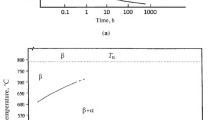Abstract
We investigate the influence of incomplete annealing (675°C, 10 h) on fatigue, corrosion-fatigue, and high-temperature (up to 500°C) fatigue resistance of titanium (a+ β)-alloy Ti-5A1- 1.5V- IMo with nominal composition as well as its welded joints made by the electron-beam method. The effect of annealing depends on a totality of factors which dominate in different ways under fatigue fracture in air, in a 3% solution of NaCl, and high-temperature fatigue. Possible mechanisms of the influence of incomplete annealing on fracture of the titanium alloy and its welded joints are analyzed.
Similar content being viewed by others
References
S. M. Gurevich (editor),Reference Book on Welding of Nonferrous Metals [in Russian], Naukova Dumka, Kiev (1990).
V. N. Moiseev, F. R. Kulikov, Yu. G. Kirillov, et al.,Welded Joints of Titanium Alloys [in Russian], Metallurgiya, Moscow (1979).
O. S. Kalakhan and N. A. Prevars’ka, “Durability of Ti-5Al-1.5V-lMo type alloy of varying structure and its welded joints in the presence of the a-layer and medium,”Fiz.-Khim. Mekh. Mater,29, No. 6, 115–117(1993).
V. I. Pokhmurskii,Corrosion Fatigue of Metals [in Russian], Metallurgiya, Moscow (1985).
S. Ya. Yarema, “Method for determining the growth rate of cracks and the characteristics of crack resistance under cyclic load,”Fiz-Khim. Mekh. Mater.,30, No. 3, 137–152 (1994);30, No. 4, 121–136 (1994);30. No. 6, 101–112 (1994);31, No. 1, 145–157 (1995).
B. Ya. Oleksiv, M. I. Frankiv, and O. S. Kalakhan,Regression Analysis in the Study of Fatigue Strength of Metals. Processing of Experimental Data [in Ukrainian], Preprint No. 27, Karpenko Physicomechanical Institute, Ukrainian Academy of Sciences, L’viv (1980), pp. 11–14.
V. M. Fedirko, O. S. Kalakhan, and I. M. Pogrelyuk, “Influence of the structure of the surface layers of nitrided titanium on its corrosion-electrochemical properties in acid solutions,”Fiz.-Khim. Mekh. Mater.,31, No. 6, 67–72 (1995).
V. I. Trufyakov (editor),Endurance of Welded Joints under Varying Loads [in Russian], Naukova Dumka, Kiev (1990).
S. I. Kishkina. F. R. Kulikov, L. A. Stronina, et al., “Low-cycle fatigue of welded joints of (a + β) titanium alloys.” in:Titanium. Physical Metallurgy and Technology [in Russian], All-Union Institute of Casting and Alloys, Moscow (1978), Vol. 2. pp. 273–282.
B. B. Chechulin and Yu. D. Khesin,Cyclic and Corrosion Durability of Titanium Alloys [in Russian], Metallurgiya, Moscow (1987).
B. A. Drozdovskii, L. V. Prokhodtseva, and N. I. Novosil’tseva,Crack Resistance of Titanium Alloys [in Russian], Metallurgiya, Moscow (1983).
G. G. Maksimovich, V. N. Fedirko, and A. T. Pichugin. “Influence of the’temperature of annealing in air on the strength properties of titanium alloys.”Fiz.-Khim. Mekh. Mater.,16, No. 5, 85–87 (1980).
O. S. Kalakhan. “Durability of welded joints made of Ti-5 Al-1.5 V-1 Mo titanium alloy of different structures after annealing,” in:Abstracts of 2nd Intern. Symp. on Mis-Matching of Welds (April 24–26, 1996. Reinstirf-Lüneburg, Germany) (1996).
V. M. Fedirko, I.M. Pohreliuk, and O. S. Kalakhan, “Corrosion behavior of surface titanium layers in acid solutions after nitrogen thermodiffusion saturation,”Werkstoffe Korrosion,49, No. 6, 435–439 (1998).
V. N. Moiseev, F. R. Kulikov, Yu. G. Kirillov, et al.,Welded Joints of Titanium Alloys [in Russian], Metallurgiya. Moscow (1979).
1.1. Komilov, N. G. Boriskina, E. M. Kenina, and M. N. Zabrodskaya, “Influence of long-term oxidation on corrosion resistance and mechanical properties of AT3 and AT6 alloys,” in:Titanium. Physical Metallurgy and Technology [in Russian], All-Union Institute of Casting and Alloys, Moscow (1978), Vol. 2. pp. 85–92.
O. S. Kalakhan, N. Ya. Yaremchenko and N. A. Prevarskaya, “Durability of titanium PT3V alloy at elevated temperatures,”Fiz.- Khim. Mekh. Mater.,21, No. 5, 9–11 (1985).
V. V. Vavilova. “Influence of oxygen on the properties of titanium and its alloys.”Metalloved. Term. Obrab. Met., No. 10. 10–12 (1973).
B. A. Kolachev,Hydrogen Brittleness of Nonferrous Metals [in Russian], Metallurgiya. Moscow (1979).
V. A. Kachuk and M. B. Svetlov, “Study of certain properties of VT5P alloy with additions of rare-earth metals,”. in:Titanium. Physical Metallurgy and Technology [in Russian], All-Union Institute of Casting and Alloys, Moscow (1978), Vol. 3, pp. 367–373.
Author information
Authors and Affiliations
Additional information
Translated from Fizyko-Khimichna Mekhanika Materialiv, Vol. 36, No. 2, pp. 76–82, March-April, 2000.
Rights and permissions
About this article
Cite this article
Kalakhan, O.S., Pokhmurs’kyi, V.I. Influence of incomplete annealing of titanium (a + β)-alloy and its welded joints on fatigue resistance and corrosion-fatigue resistance. Mater Sci 36, 244–251 (2000). https://doi.org/10.1007/BF02767545
Received:
Issue Date:
DOI: https://doi.org/10.1007/BF02767545




